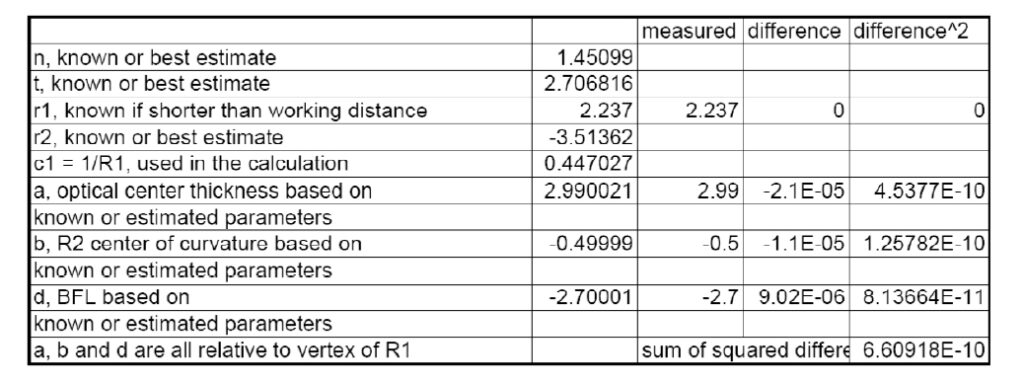Reverse Engineering Lens Elements
Introduction
- Need for reverse engineering
- Properties necessary for reverse engineering
- How to make necessary measurements
- How to calculate the paraxial properties
- Use of a spreadsheet for the solution
- Use of a lens design program to find a solution
Need for reverse engineering
- Actually want to copy someone’s design
- Concern that lens may be wrong glass
- Lenses got mixed up, need to sort out
- Lens system does not work – right elements?
Properties needed to reverse engineer
- Just looking for paraxial properties
- These are the properties on an optical drawing
- Two radii
- Glass type or index at the measurement wavelength
- Center thickness
- Could measure physically, but may not want to, or can’t
Measurements needed
- Radius of curvature but may not have working distance – reverse lens so backside concave
- Optical center thickness to rear vertex
- Back focal length from one or both sides
- Need at least 4 measurements to solve for 4
unknowns - Extra measurements increase confidence
Measurements that can be made

Center thickness

Rear Radius

Back focal length

No closed form solution for unknowns
- Use spreadsheet
- Find difference between measured & guessed values
- Square differences and sum
- Make sum zero by varying unknowns
- Use a lens design program
- Model the various measurement configurations
- Use multi-configuration option
- Use plane surfaces, guess thickness and a model for index
- Use optimizer to find solution
Spreadsheet example

N, t and r2 were estimated and a, b and c calculated
Solver used to minimize lower right hand cell to give calculated n, t and r2 shown above.
Lens design example

Configuration 1 shown for calculation of bfl
Grayed out lines are ignored
Lens design example con’t 1

Configurations 1, 2 and 3 are looking thru short radius first
Configurations 4,5 and 6 are looking thru long radius first
Line 2 shows what the measurements should be knowing the index, thickness and two radii
Lens design example con’t 2

Lens design example con’t 3

Radii, thickness and index are set as variables
Optimized with small entrance pupil for paraxial solution
Conclusions
- Use all practical conjugate measurements in model
- Works with interferometer or autostigmatic microscope
- Works for doublets as well as singlets
- Can usually see cement interface
- Often better reflection than AR coated surfaces
- Just a more complicated lens design model
- Need to know surfaces from centers of curvature
- Remember to stop down model before optimization
- Model must find first order solution
- All in all, pretty easy to do
USA

Innovations Foresight
4432 Mallard Point,
Columbus, IN 47201 USA
Telephone:
1-215-884-1101
Contact:
Customerservice@
All Asian Countries Except China

清 原 耕 輔 Kosuke Kiyohara
清原光学 営業部 Kiyohara Optics / Sales
+81-3-5918-8501
opg-sales@koptic.co.jp
Kiyohara Optics Inc.
3-28-10 Funado Itabashi-Ku Tokyo, Japan 174-0041
China

Langxin (Suzhou) Precision Optics Co., Ltd
1st floor, Building 10, Yisu Science and Technology Innovation Park, 100 meters west of the intersection of Xinhua Road and Weimeng Road, Kunshan City, Suzhou City, Jiangsu Province, 215345
Telephone: +860512-57284008
Contact: Wang Zengkun
+8617090133615
wangzengkun@langxinoptics.com
Copyright ©
Website by CS Design Studios
Headquarters: 7011 E Calle Tolosa, Tucson, AZ 85750
Laboratory: 1661 S Research Loop, Tucson, AZ 85710
